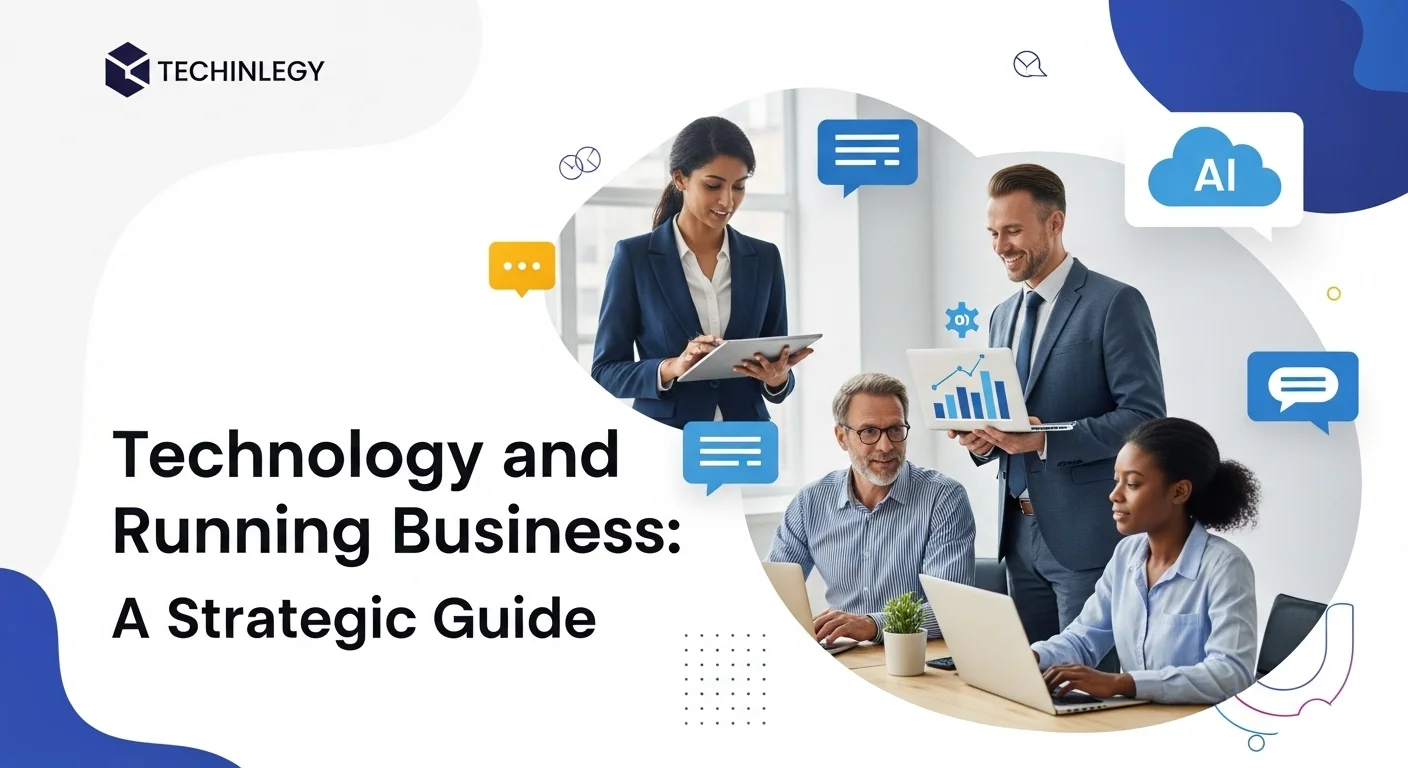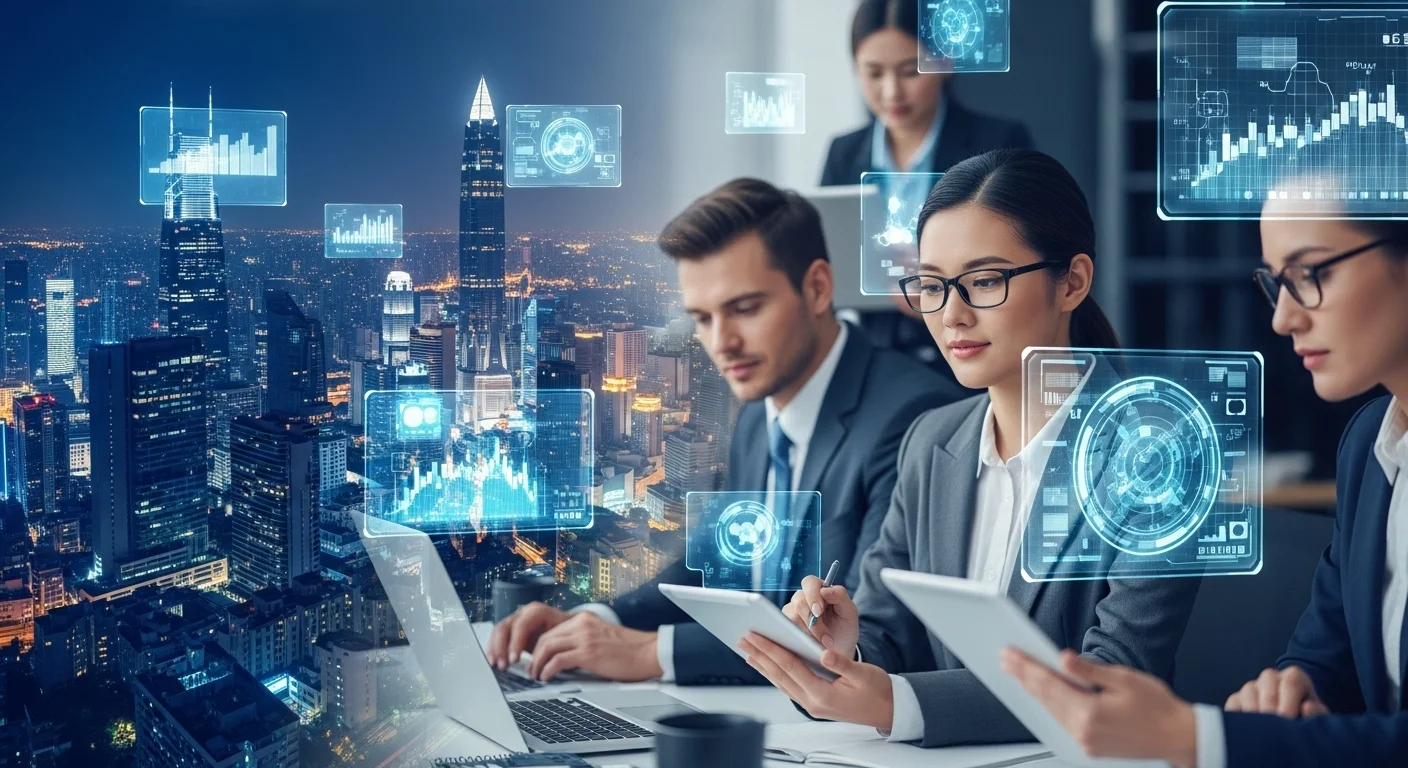The Modern Entrepreneur's Tech Playbook: Powering Your Business from Home

Executive Summary
In my years helping entrepreneurs, I've seen one thing change the game more than anything else: technology. It's no longer just a tool; it's the very foundation of a modern, successful business. This guide is your roadmap to understanding how technology, business, and entrepreneurship connect. We'll walk through the essentials like Artificial Intelligence (AI), cloud computing, and cybersecurity, breaking them down into simple terms. My goal is to show you how these powerful tools can streamline your work, help you make smarter decisions, and protect your hard work. I'll pay special attention to the realities of launching and growing a business from home, highlighting the tech that truly levels the playing field. Whether you're just starting out or looking to optimize your current company, this guide will give you the confidence to use technology to build a resilient and future-ready business.
Table of Contents
Table of Contents
- The Digital Shift: Why Technology is the Heart of Modern Business
- Your Essential Tech Toolkit: A Practical Guide
- Building Your Foundational Tech Stack
- Using Advanced Tech: AI and Cloud Solutions
- Must-Have Business Skills for the Digital Age
- From Good to Great: Advanced Tech Strategies for Scaling Your Business
The Digital Shift: Why Technology is the Heart of Modern Business
Running a business today looks completely different than it did even a decade ago. I remember when the biggest hurdles were physical overhead and manual paperwork. Now, the entire landscape has shifted online. A modern business operates within a digital ecosystem, and success often comes down to how well you can use technology to work smarter, not harder. This isn't just about scanning documents or using email; it's about fundamentally rethinking how you operate through a tech-focused lens. Technology is the great enabler—it boosts your efficiency, helps you scale, and opens up new markets. For entrepreneurs, especially those starting a business from home, it's the key that unlocks doors that were once only open to massive corporations. It's because of tech that so many incredible home-based businesses are not only possible but profitable.
So, why is this so important? At its core, technology handles the repetitive, time-consuming tasks for you. Think about all the hours spent on invoicing, inventory, or basic customer follow-ups. Automation frees you up to focus on what truly matters: your vision, your creativity, and building real relationships with your customers. Beyond automation, technology gives you the power of data. With cloud computing, you can store and access huge amounts of information, and with AI, you can analyze that data to spot trends, understand what your customers want, and make decisions based on facts, not just gut feelings. This is a complete game-changer. For instance, an e-commerce shop run from a spare bedroom can use analytics to see which products are hot and use AI to give customers personalized recommendations, creating a top-tier experience. This is how technology helps create flexible, powerful businesses that can be run from anywhere.
The Rise of the Home-Based, Tech-Powered Business
The dream of being your own boss from the comfort of your home has been around forever, but it was technology that made it a tangible reality for millions. Fast internet, affordable laptops, and powerful online software have torn down the old barriers to starting a business. Today, some of the most straightforward businesses are entirely digital, needing little more than a good idea and an internet connection. I've worked with countless freelance writers, graphic designers, and social media managers who have built thriving careers from their kitchen tables. They use platforms like Upwork to find clients, tools like Trello to manage projects, and services like Stripe to get paid. Technology handles the logistics, so they can focus on their craft.
The advantages are huge. As a business owner, you cut down on major costs—no office rent, no commute—and gain incredible flexibility in your schedule. This has created a more vibrant and diverse entrepreneurial world. Take a dropshipping e-commerce store, for example. The owner never touches a single product. The entire system, from the customer placing an order to the supplier shipping it out, is managed through digital platforms. Or think about selling digital products like online courses or e-books. You create it once, and technology allows you to sell it an infinite number of times with almost no extra cost. These examples show that for a home business, technology isn't just a helper; it's the very engine that makes it run.
The Three Pillars: Cloud, AI, and Cybersecurity
To really get a handle on how tech is changing business, you need to understand three core pillars: cloud computing, artificial intelligence (AI), and cybersecurity.
Cloud Computing: The Foundation for Agility. The cloud has been the single biggest game-changer for businesses in the last 20 years. Simply put, it means accessing services—like servers, storage, and software—over the internet instead of hosting them on your own physical hardware. Companies like Amazon Web Services (AWS), Google Cloud, and Microsoft Azure let you 'rent' this infrastructure. For a new business, this means you can launch with very little upfront cost and scale up instantly as you grow. If you're running a business from home, the cloud is your best friend. It gives you access to professional-grade tools like QuickBooks Online for accounting or Google Workspace for collaboration, all available on any device, anywhere. This freedom is what makes a remote business not just possible, but efficient.
Artificial Intelligence (AI): The Engine for Innovation. If the cloud is the foundation, AI is the engine powering the future. AI systems perform tasks that normally require human intelligence, like learning and problem-solving. In business, its uses are exploding. AI chatbots can handle customer questions 24/7, freeing up your time. AI-driven analytics can predict market trends or personalize your marketing with incredible accuracy. For a solo entrepreneur, AI tools are like having an extra team member. They can help you draft blog posts, manage your social media, and optimize your ad campaigns. These tools level the playing field, making sophisticated business strategies accessible to everyone.
Cybersecurity: The Shield for Your Assets. In a digital world, your data is your most valuable asset, and protecting it is non-negotiable. Cybersecurity is all about the practices and technologies you use to protect your digital life from threats. A data breach can be devastating, leading to lost money, a damaged reputation, and legal trouble. Small businesses are often seen as easy targets, so you have to be vigilant. This starts with the basics: using strong, unique passwords, setting up multi-factor authentication (MFA), and keeping your software updated. If you work from home, securing your Wi-Fi network and using a VPN are critical. Regularly backing up your important files to a secure cloud service is also a must. While it might seem intimidating, good cybersecurity is simply responsible business ownership in the digital age. It ensures your hard work stays safe and secure.

Your Essential Tech Toolkit: A Practical Guide
Starting a business today means choosing the right digital tools. Think of it as building a workshop; you need the right equipment to do the job well. A successful venture, whether it's a side hustle or a full-time enterprise, depends on a smart, well-chosen 'tech stack'. This guide will walk you through building that stack, with a focus on practical solutions for anyone running a business from home. By mastering these tools, you can turn a simple idea into a competitive and efficient company.
Building Your Foundational Tech Stack
Your tech stack is the collection of software and platforms that power your business. The key is to find tools that are powerful, affordable, and can grow with you. Here are the essentials I always recommend.
1. Hardware and Connectivity: This is your base layer. You need a reliable computer and a fast internet connection. From personal experience, don't skimp on ergonomics—a good chair and an external monitor can save you from a world of back pain and eye strain. A simple multi-function printer/scanner is also incredibly handy for those rare times you have to deal with paper.
2. Core Productivity and Collaboration: These are your daily drivers. Cloud-based suites like Google Workspace or Microsoft 365 are the gold standard. They give you professional email, cloud storage (Google Drive, OneDrive), and video conferencing tools (Meet, Teams), which are essential for working with clients or team members. For organizing your work, project management tools like Trello, Asana, or ClickUp are a must. They turn a chaotic to-do list into a clear, manageable plan.
3. Financial Management: Getting your finances right from day one is crucial. I've seen too many entrepreneurs get buried in spreadsheets. Cloud accounting software like QuickBooks Online, Xero, or FreshBooks automates invoicing, tracks expenses, and gives you a clear, real-time picture of your financial health. They connect directly to your bank and payment processors like Stripe or PayPal, making cash flow management so much easier.
4. Customer Relationship Management (CRM): As you grow, you can't keep track of every customer interaction in your head or email. A CRM is a central hub for all your customer data. For a home-based business, this is how you provide personal, attentive service at scale. Platforms like HubSpot CRM (which has a fantastic free version), Salesforce Essentials, or Zoho CRM help you manage leads, track conversations, and build real relationships.
5. Marketing and Online Presence: Your website is your digital storefront. User-friendly builders like Squarespace, Wix, or the more versatile WordPress are where you start. If you're selling products, e-commerce platforms like Shopify or WooCommerce are the backbone of your operation. To connect with your audience, you'll need an email marketing service like Mailchimp or ConvertKit and a social media scheduler like Buffer or Hootsuite to keep your marketing consistent without taking over your life.
Using Advanced Tech: AI and Cloud Solutions
Once you have the foundation, you can start using more advanced technologies to get a real competitive edge.
Cloud Computing in Practice: The cloud is more than just storage. Most small businesses will primarily use SaaS (Software as a Service)—this is when you subscribe to online software like Google Workspace or Shopify. It's the simplest and most cost-effective way to access powerful tools without needing a team of engineers. As businesses grow, they might use PaaS (Platform as a Service) to build custom apps or IaaS (Infrastructure as a Service) to host complex websites, but for most home-based entrepreneurs, SaaS is the sweet spot.
Putting Artificial Intelligence (AI) to Work: AI isn't just for tech giants anymore. There are plenty of accessible tools that can supercharge your business:
- Customer Support: Use a chatbot service like Tidio or Drift on your website to answer common questions instantly, day or night.
- Marketing and Content: Feeling stuck on what to write? AI tools like Jasper or Copy.ai can help you brainstorm blog topics, draft social media posts, and write emails.
- Operational Efficiency: This is where the magic happens. Tools like Zapier or Make let you connect your apps and automate workflows. For example, you can set it up so that when someone buys from your Shopify store, an invoice is automatically created in QuickBooks and the customer is added to your Mailchimp newsletter. This is how you build a business that runs itself.
Must-Have Business Skills for the Digital Age
The best tools are useless without the right strategy. Here are the skills you need to master.
Data-Driven Decision Making: Don't guess, know. Use Google Analytics to see how people find and use your website. Look at your CRM data to understand who your best customers are. Your accounting software will tell you what your most profitable services are. Making decisions based on this data will dramatically increase your chances of success.
Digital Marketing Fundamentals: You need to get the word out. Focus on:
- Search Engine Optimization (SEO): Helping people find you on Google. It's a long-term strategy that pays off with free, consistent traffic.
- Content Marketing: Creating helpful content (blogs, videos) that builds trust and establishes you as an expert.
- Social Media Marketing: Engaging with your community where they hang out online.
- Paid Advertising: Using Google Ads or Facebook Ads for a quick, targeted traffic boost. Just be sure to manage your budget carefully.
Cybersecurity Best Practices: Protecting your business is your responsibility.
- Strong Authentication: Use a password manager like 1Password or LastPass to create unique, strong passwords for everything. Always turn on multi-factor authentication (MFA).
- Secure Your Network: If you work from home, make sure your Wi-Fi is password-protected with WPA3 encryption. A VPN is a must when using public Wi-Fi.
- Regularly backing up your important files: Back up all your critical data regularly. A dedicated service like Backblaze provides an extra layer of security against disaster.
- Software Updates: Keep everything updated. Those update notifications often contain crucial security fixes that protect you from hackers.
By thoughtfully combining the right tools with modern strategies, any entrepreneur can build a powerful operation. This approach makes running a business from home not just possible, but scalable, resilient, and ready for whatever comes next.

From Good to Great: Advanced Tech Strategies for Scaling Your Business
Once you've set up your basic technology, the journey isn't over. The real magic happens when you start refining your processes, adopting smarter tools, and fostering a mindset of constant improvement. In my experience, this is the stage where a good business becomes a great one. These advanced tips are designed to help you get more out of your tech, especially if you're a solo entrepreneur or small team working from home. This is how you maximize your efficiency and impact.
Optimizing Your Tools and Workflows
Your technology should grow and change with your business. It's crucial to review your setup regularly to make sure it's still working for you.
1. Conduct a Quarterly Tech Audit: Every three months, I sit down and review every piece of software I pay for. I ask myself: Is this tool still helping me? Am I really using it? Is there a better or cheaper option out there? This simple habit prevents 'tech bloat'—paying for things you don't need—and keeps your budget lean. For a home-based business, every dollar counts, making this a critical discipline.
2. Master Workflow Automation: This is where you can find huge productivity wins. Go beyond simple connections and explore advanced workflows with tools like Zapier, Make, or Microsoft Power Automate. Imagine a new client fills out your contact form. You can create a 'zap' that automatically adds them to your CRM, sends a personalized welcome email, creates a follow-up task in your project manager, and adds their info to a tracking spreadsheet. Automating these multi-step processes frees you from administrative busywork and lets you focus on high-value strategy.
3. Embrace No-Code and Low-Code Platforms: This is one of the most exciting trends for entrepreneurs who aren't developers. Platforms like Bubble, Adalo, or Softr let you build your own custom web apps without writing code. Need a custom dashboard to track your most important metrics? A special portal for your clients to log into? These tools make it possible to build the exact solution you need, helping you innovate and stand out from the competition.
Advanced Strategies for Growth and Security
As you grow, your strategies need to mature to handle more complexity and greater risk.
4. Dig Deeper with Data Analytics: Go beyond just looking at website traffic. Set up conversion goals in Google Analytics to track the entire customer journey from start to finish. I highly recommend exploring free business intelligence (BI) tools like Google Looker Studio or Microsoft Power BI. They let you create dashboards that pull in data from all your different tools (CRM, accounting, marketing) into one place. This gives you a holistic view, helping you discover powerful insights, like which marketing channels bring in the most valuable long-term customers.
5. Build a Proactive Cybersecurity Culture: Cybersecurity isn't just about software; it's about habits.
- Awareness and Training: If you work with freelancers or have employees, they can be a security risk. Regularly talk about how to spot phishing scams and the importance of good password hygiene.
- Data Minimization: A simple rule I follow: only collect the data you absolutely need. The less sensitive information you store, the less risk you have if a breach ever occurs.
- Create an Incident Response Plan: Think about it now: what would you do if you were hacked? Having a simple, clear plan—who to call, how to lock down your systems, how to communicate with customers—can make a huge difference in a crisis.
6. Build Your Personal Brand Through Tech: In a noisy digital world, a strong personal brand is a massive advantage. Use technology to establish yourself as an expert in your field. Start a blog, a podcast, or a YouTube channel. Host webinars. Be active and helpful on LinkedIn. Sharing your knowledge and journey not only attracts clients but also builds invaluable trust and authority.
Real-World Tech Evolution: A Quick Case Study
Think of a freelance graphic designer starting out from home.
- Day 1: They begin with a MacBook, Adobe Creative Cloud, and Google Workspace. They manage clients with a simple spreadsheet.
- 6 Months In: The spreadsheet is a mess. They sign up for HubSpot's free CRM to track projects and use Calendly to let clients book meetings automatically. They start using QuickBooks for professional invoices.
- 1 Year In: To scale, they use Zapier to connect HubSpot and QuickBooks, so invoices are generated automatically when a project is done. They start a blog to showcase their expertise, using an AI assistant to help brainstorm ideas. They use Buffer to schedule social media posts promoting their content. This strategic use of tech lets their one-person business operate with the efficiency of a small agency.
Staying Ahead of the Curve
Technology moves fast. I make it a habit to set aside a little time each week just for learning. Follow reputable tech sources like TechCrunch, WIRED, or The Verge. Listen to podcasts on your commute or while doing chores. To really understand the strategic side of how technology is reshaping business, I often turn to the MIT Sloan Management Review. They offer incredible, research-backed articles on tech innovation.
By adopting these strategies, you shift from being a simple user of technology to a strategic operator. This proactive and informed approach is the ultimate key to building a successful, resilient, and innovative business, no matter where you work.
Expert Reviews & Testimonials
Sarah Johnson, Business Owner ⭐⭐⭐⭐
This was a solid overview. As a small business owner, I found the section on building a tech stack really helpful. I would have loved a few more real-world examples of how other home businesses use these tools day-to-day.
Mike Chen, IT Consultant ⭐⭐⭐⭐
A great guide that connects all the dots between tech and business operations. I often explain these concepts to clients, and this article breaks them down clearly. The cybersecurity section is especially on-point.
Emma Davis, Tech Expert ⭐⭐⭐⭐⭐
Fantastic article! As a tech strategist, I appreciate the comprehensive yet easy-to-digest approach. It covers the foundational pillars and advanced strategies perfectly. I'll be sharing this with my network.



